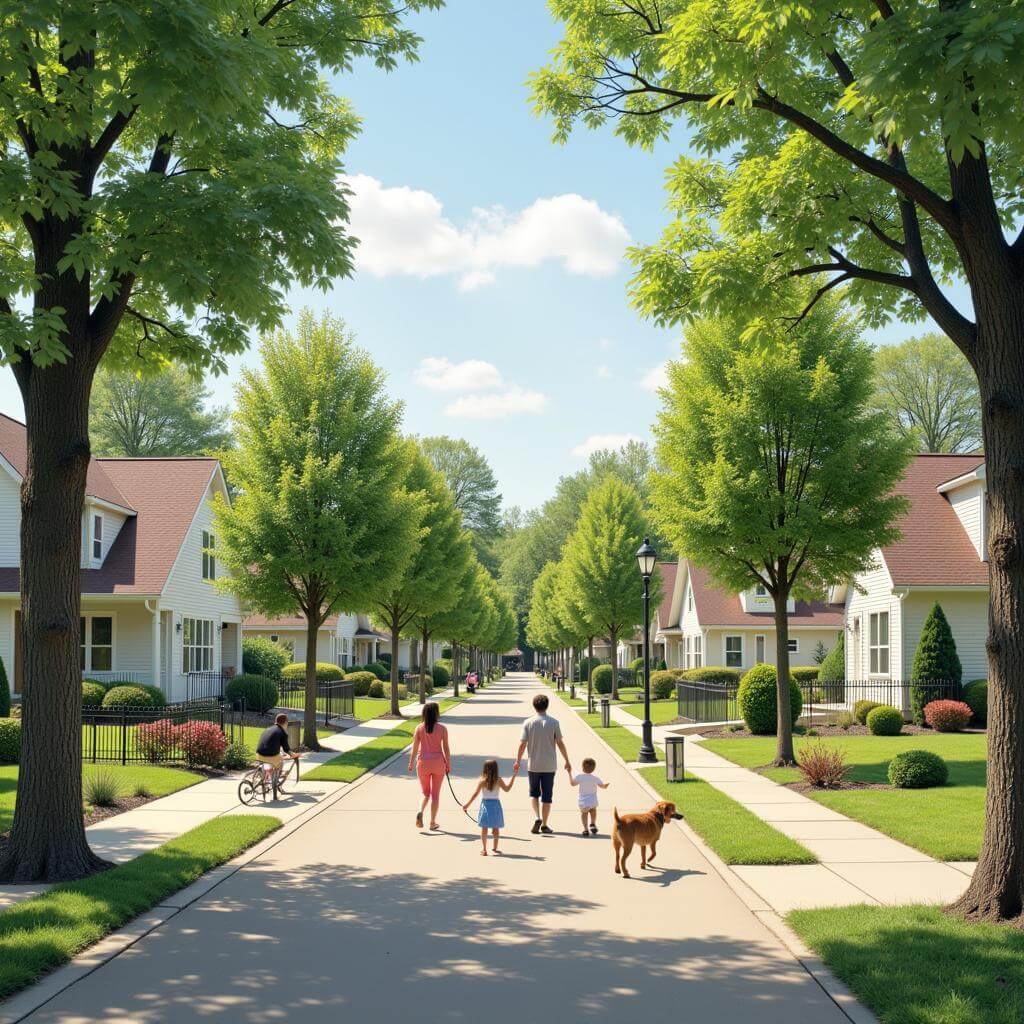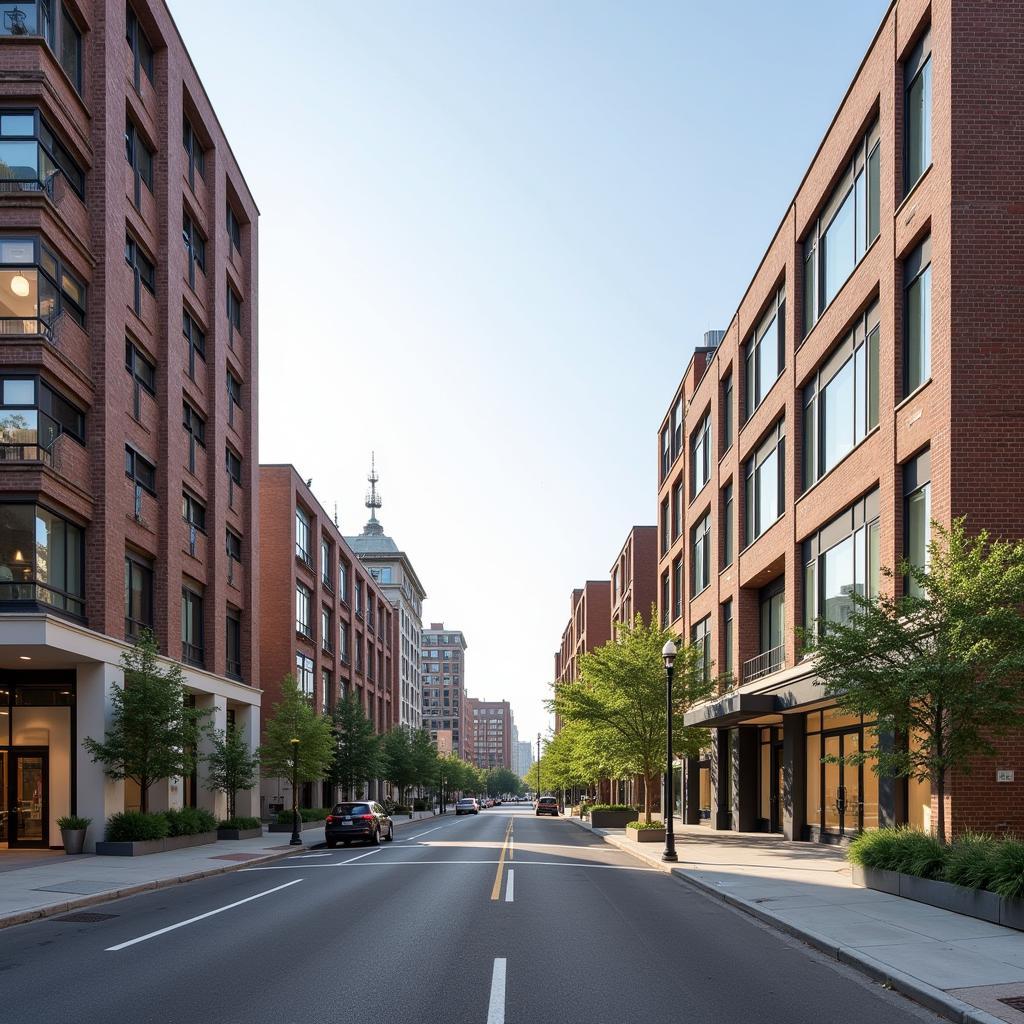Describing a neighborhood you often visit is a common topic in IELTS Speaking tests, particularly in Part 2. This theme allows candidates to showcase their vocabulary, fluency, and ability to structure a coherent response. It’s essential to be prepared for this topic as it has appeared frequently in past exams and is likely to continue being a popular choice for examiners.
Part 1: Introduction and Interview
In Part 1, the examiner may ask general questions about your neighborhood or areas you like to visit. Here’s a sample question with a suggested answer:
Question: Do you prefer to live in the city center or in a quiet neighborhood?
Answer (Band 7-8):
“I actually prefer living in a quiet neighborhood rather than the bustling city center. While the downtown area certainly has its advantages, such as convenience and proximity to various amenities, I find that a more tranquil residential area suits my lifestyle better. It offers a peaceful environment where I can relax after a long day at work and enjoy some green spaces. Moreover, quiet neighborhoods often have a stronger sense of community, which I really value.”
 Quiet neighborhood with green spaces
Quiet neighborhood with green spaces
Part 2: Long Turn
Cue Card:
Describe a neighborhood in your city you often visit
You should say:
- Where it is located
- What it looks like
- What kind of people live there
- And explain why you like visiting this neighborhood
Sample Answer (Band 8-9):
“I’d like to talk about a neighborhood I frequently visit called Riverside District, which is located in the eastern part of my city, about a 15-minute drive from the city center. This area is renowned for its picturesque setting along the banks of the River Thames, offering a perfect blend of urban convenience and natural beauty.
The neighborhood is characterized by its charming mix of Victorian-era townhouses and modern apartment complexes, all of which are meticulously maintained. The streets are lined with mature trees, creating a verdant canopy that provides shade and adds to the area’s aesthetic appeal. One of the most striking features of Riverside District is its expansive waterfront promenade, which stretches for several kilometers and is adorned with vibrant flower beds and stylish benches.
The residents of this neighborhood are quite diverse, ranging from young professionals to retired couples. There’s a significant population of artists and creatives, which is reflected in the numerous art galleries and boutique shops that dot the main street. You’ll also find a fair number of families, attracted by the excellent schools and safe environment.
I’m particularly fond of visiting this neighborhood for several reasons. Firstly, the serene atmosphere by the river provides a welcome respite from the hustle and bustle of city life. It’s an ideal place for a leisurely stroll or a peaceful afternoon of reading in one of the well-manicured parks. Secondly, the area boasts an eclectic mix of cafes and restaurants, offering cuisines from around the world. I often find myself exploring new culinary delights each time I visit.
Moreover, the strong sense of community in Riverside District is palpable. The locals are incredibly friendly and welcoming, and there’s always some sort of community event happening, be it an art fair, a farmers’ market, or a musical performance in the park. This vibrant community spirit makes each visit feel like a mini-adventure, full of new experiences and encounters.
In essence, Riverside District encapsulates everything I love about urban living – the perfect balance of nature, culture, and community. It’s a place that never fails to uplift my spirits and remind me of the joys of city life.”
Follow-up questions:
- How has this neighborhood changed over the years?
Answer (Band 7-8):
“From what I’ve observed and heard from long-time residents, Riverside District has undergone quite a transformation over the past decade or so. Initially, it was primarily a residential area with limited amenities. However, in recent years, there’s been a significant influx of businesses, particularly in the creative and hospitality sectors. This has led to the revitalization of many older buildings and the development of new, mixed-use spaces. The waterfront area, which was once rather neglected, has been completely rejuvenated with the addition of the promenade and various recreational facilities. While these changes have certainly made the neighborhood more vibrant and attractive, they’ve also led to some challenges, such as increased property prices and concerns about maintaining the area’s original character.”
- Do you think it’s important for neighborhoods to have a distinct identity?
Answer (Band 8-9):
“I firmly believe that having a distinct identity is crucial for the vitality and sustainability of any neighborhood. A unique character not only makes an area more appealing to residents and visitors but also fosters a stronger sense of community. When a neighborhood has a clear identity, it often leads to increased civic pride and engagement among its residents, who are more likely to participate in local events and initiatives.
Moreover, a distinct identity can serve as a catalyst for economic development. Neighborhoods known for specific attributes – be it their architecture, cultural offerings, or culinary scene – tend to attract businesses and investments that align with and enhance these characteristics. This, in turn, can create a virtuous cycle of improvement and growth.
However, it’s important to strike a balance. While cultivating a unique identity, neighborhoods should remain inclusive and adaptable to changing demographics and needs. The most successful neighborhoods, in my opinion, are those that manage to preserve their core essence while evolving to meet the demands of modern urban life.”
Part 3: Two-way Discussion
Examiner: Let’s talk about urban development. How do you think city planners can balance the need for new housing with preserving the character of existing neighborhoods?
Answer (Band 8-9):
“Balancing urban development with neighborhood preservation is indeed a complex challenge that requires a multifaceted approach. I believe city planners need to adopt several strategies to achieve this delicate equilibrium.
Firstly, adaptive reuse of existing structures should be prioritized wherever possible. This involves repurposing old buildings for new uses while maintaining their historical facade and character. For instance, converting former warehouses into loft apartments or transforming disused factories into mixed-use spaces. This approach not only preserves the architectural heritage but also injects new life into older areas.
Secondly, when new construction is necessary, it should be done with careful consideration of the existing architectural styles and urban fabric. This doesn’t mean slavishly copying old designs, but rather creating modern structures that complement and enhance the existing neighborhood aesthetic. Height restrictions, setback requirements, and design guidelines can be implemented to ensure new buildings don’t overwhelm or detract from the established character.
Another crucial aspect is community engagement. City planners should actively involve local residents in the decision-making process through public consultations, workshops, and collaborative design sessions. This not only ensures that development aligns with community needs and values but also fosters a sense of ownership and acceptance among residents.
Furthermore, mixed-income housing initiatives can help maintain the socio-economic diversity of neighborhoods undergoing development. This prevents the wholesale displacement of long-time residents and preserves the community’s social fabric.
Lastly, investing in public spaces and infrastructure improvements alongside housing development can help integrate new elements more seamlessly into existing neighborhoods. This might include creating new parks, enhancing pedestrian and cycling facilities, or upgrading public transit options.
By employing these strategies, city planners can work towards creating vibrant, evolving urban spaces that respect and build upon the unique character of established neighborhoods, rather than erasing it.”
 Urban development balancing old and new architecture
Urban development balancing old and new architecture
Key Vocabulary and Phrases for High Scores
-
Renowned /rɪˈnaʊnd/ (adjective): Famous or well-known.
Example: The neighborhood is renowned for its beautiful parks. -
Picturesque /ˌpɪktʃəˈresk/ (adjective): Visually attractive, especially in a quaint or charming way.
Example: The picturesque streets are lined with colorful houses. -
Verdant /ˈvɜːrdnt/ (adjective): Green with grass or other rich vegetation.
Example: The verdant gardens add beauty to the area. -
Palpable /ˈpælpəbl/ (adjective): Able to be touched or felt; obvious or evident.
Example: There’s a palpable sense of community in this neighborhood. -
Eclectic /ɪˈklektɪk/ (adjective): Deriving ideas, style, or taste from a broad and diverse range of sources.
Example: The neighborhood offers an eclectic mix of architectural styles. -
Revitalization /ˌriːˌvaɪtəlaɪˈzeɪʃn/ (noun): The action of giving new life or vigor to something.
Example: The revitalization of the old town center has attracted many new businesses. -
Catalyst /ˈkætəlɪst/ (noun): A person or thing that precipitates an event or change.
Example: The new community center acted as a catalyst for increased social interaction. -
Multifaceted /ˌmʌltiˈfæsɪtɪd/ (adjective): Having many different aspects or features.
Example: Urban planning is a multifaceted discipline that requires diverse skills.
Examiner’s Advice: To achieve a high score in the IELTS Speaking test, practice using these advanced vocabulary items and complex sentence structures in context. Focus on developing your ideas fully and providing specific examples to support your points. Additionally, work on your pronunciation and fluency to ensure clear and confident delivery of your responses.
For more practice on describing places, you might find it helpful to describe a city you would like to live in one day or describe a park you enjoy visiting in your city. These topics will help you expand your vocabulary and improve your ability to discuss urban environments in detail.


